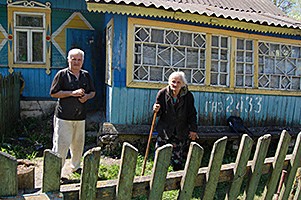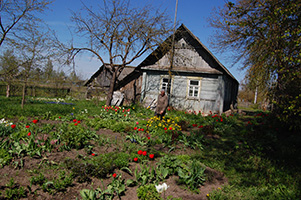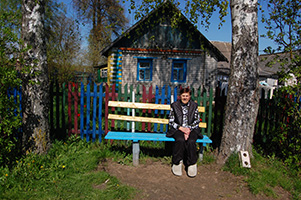

|
The Holocaust in Rossasna
The Nazis conquered Belarus
in early 1941, and just as they did elsewhere, established ghettos which were
subsequently “liquidated“.
The Germans captured Rossasna
in July of 1941. They moved all the Jews
into only six houses at the end of Dubrovenskaya Street. Policemen constantly watched the Jews, and
people were warned not to visit them.
The Jews were starving, and they were also not allowed to heat their
homes once the weather changed. Men and
young women were taken for work. Reports
differ as to the fate of the Jews. One
account holds that near the end of 1941, during a snowstorm, all the Jews were
taken to the market square, counted, and then marched to the ghetto in Lyady. No one saw
them after that. Another
account states that the Jews weren’t taken to Lyady
until 2 Apr 1942, where they were murdered along with the local Jews. However, it is known that there is a mass
grave just outside of Rossasna, where almost 200
local Jews were killed. And after the
war, about twenty dead bodies, mostly elderly people, were found along the road
to Lyady.
Locals collected their bodies and buried them in the Jewish cemetery.
As part of my research, I requested that local people be
interviewed about the war. Three elderly
women shared their reminiscences about that era. Nadezhda B.
recalled that the primary school she attended had many Jewish students and
teachers. She said her father, a noted
cooper (barrel maker), felt very positively about the Jews, and that people got
along well. Anna R. noted that it was
very painful to talk about this time, as it had affected her personally. Her father was shot by the Nazis before her
eyes because he refused to join the police.
Anna also related that people
were shot for being communists as well, including the Jewish head of the nearby
collective farm. The communists were
rounded up during the first days of the Nazi occupation and shot near the
Jewish cemetery. She also remembered a “mixed” family in which the husband was
Christian and the wife Jewish. The Nazis
sent his wife to the Lyady ghetto; he was able to
exchange the lives of his children for payments of gold. Her Jewish friend named Sonia, who shared the
same desk with her at school, was sent with her family to the Lyady ghetto and did not return. The home of Mariya
S. was burned down at the start of the war, and her father built a dugout in
which the family lived until the end of the war. Mariya
also mentioned that after the war, the new owners of a previously Jewish owned
home found kitchenware that had been buried in the cellar.
Of the two streets primarily inhabited by
Jews (Dubrovenskaya and Orshanskaya
Streets), nearly all the houses on Orshanskaya Street
were burned down when Rossasna was liberated by the
Russians.
Very few Jews returned to Rossasna after the war; and those who did return did not
stay long. Anna and Nadezhda
both remembered a man named Nahum or Nokhimke who had
managed to escape from the ghetto and join the partisans. He lost his entire family during the
war. After he returned, he stayed for
only three or four years before moving to Orsha. Today, there are no Jews remaining in Rossasna. Any
children who had grown up in mixed families and survived the war adopted
Christianity.

(click to enlarge) |

(click to enlarge) |

(click to enlarge) |
Other than the testimonies of the people
interviewed, there is very little written about life in the ghetto in Rossasna during the war that I have been able to find. However, the Yizkor
(memorial) book for Belarus features a description of the ghetto in Orsha, the nearest large town to Rossasna,
which I have paraphrased below.
Conditions were certainly very similar in Rossasna.
“There was a curfew and
food rationing. The 2,000 Jews of the
town were forced into the ghetto, which comprised only twenty houses. Jews lived in attics, sheds, and former
business sites. Planks were pulled up to
use as beds. A collective fine of 250,000
rubles was imposed, which people paid in cash and in valuable objects. The Germans promised that the Jews would soon
be sent to Mandatory Palestine, and in this manner, order was kept. In November
1941 the ghetto was liquidated, with most of the Jews being deported to
concentration camps and killed on arrival.
The remaining Jews were ordered to dig trenches in a ravine just outside
of town, then forced to undress and were shot.
In 1943, to hide the evidence of their actions, the Germans unearthed
the corpses, which were then burned in twenty-four large tubs that had been
previously used as pickling vats.”
Since the Germans did not
record the names of these people, there is only survivor testimony, or lists
compiled after the war by investigative commissions, to use as a reference. Due to the dearth of survivors, and the
haphazard way in which the lists were compiled, most of the names of the dead
will never be known.
Created by JP February 2016
Last updated by JP January 2018
copyright © February 2016 Judy Petersen
Email: Judy Petersen
| Belarus SIG
Home Page |
JewishGen
Belarus Database |
KehilaLinks
Home Page |
||||
Jewish Gen Home Page | ShtetLinks Directory
This site is hosted at no cost by JewishGen,
Inc., the Home of Jewish Genealogy.
If you have been aided in your
research by this site and wish to further our
mission of preserving our
history for future generations, your
JewishGen-erosity
is greatly appreciated.